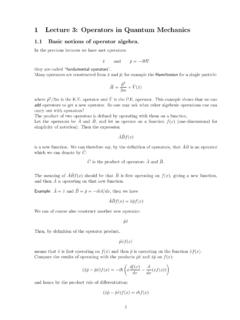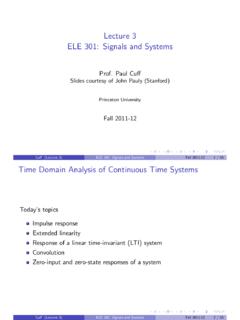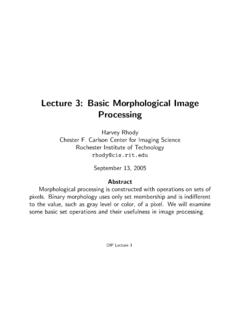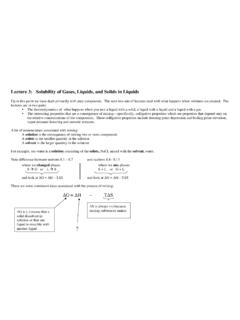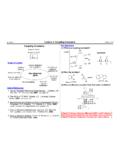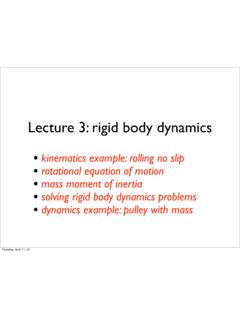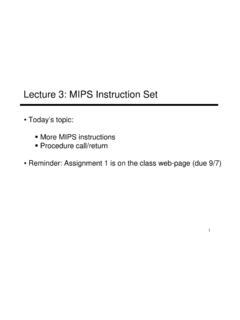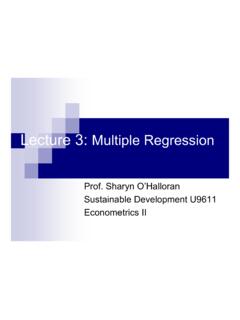Search results with tag "Lecture 3"
Introduction to Quantum Field Theory for Mathematicians
souravchatterjee.su.domainsThe postulates of quantum mechanics 5 Lecture 3. Position and momentum operators 9 Lecture 4. Time evolution 13 Lecture 5. Many particle states 19 Lecture 6. Bosonic Fock space 23 Lecture 7. Creation and annihilation operators 27 Lecture 8. Time evolution on Fock space 33 Lecture 9. Special relativity 37 Lecture 10. The mass shell 41 Lecture 11 ...
1 Lecture 3: Operators in Quantum Mechanics - spbu.ru
www.phys.spbu.ru1 Lecture 3: Operators in Quantum Mechanics 1.1 Basic notions of operator algebra. In the previous lectures we have met operators: ^x and p^= i hr
ECON 600 Lecture 3: Profit Maximization
www.csun.eduECON 600 Lecture 3: Profit Maximization I. The Concept of Profit Maximization Profit is defined as total revenue minus total cost. Π = TR – TC
Lecture 3 ELE 301: Signals and Systems - Princeton …
www.princeton.eduLecture 3 ELE 301: Signals and Systems Prof. Paul Cu Slides courtesy of John Pauly (Stanford) Princeton University Fall 2011-12 Cu (Lecture 3) ELE 301: Signals and Systems Fall 2011-12 1 / 55 Time Domain Analysis of Continuous Time Systems Today’s topics Impulse response Extended linearity Response of a linear time-invariant (LTI) system ...
Lecture 3: Coupling Constants Chem 117 - GitHub Pages
ekwan.github.ioE. Kwan Lecture 3: Coupling Constants Chem 117 Here is the observed spectrum at 90 MHz in CDCl 3 (Lambert and Mazzola, pg 101): Uh oh: there are some 10 lines visible! Note that this odd appearance will not be improved by going to a higher magnetic field strength.
Lecture 3: Basic Morphological Image Processing
www.cis.rit.eduSep 13, 2005 · Set Operations Let A and B be sets. If a is the index of a pixel in A, then we write a ∈ A. If a is not in A we write a /∈ A. If every element that is in A …
Lecture 3: Solubility of Gases, Liquids, and Solids in Liquids
laude.cm.utexas.eduLecture 3: Solubility of Gases, Liquids, and Solids in Liquids Up to this point we have dealt primarily with pure compounds. The next two sets of lectures deal with what happens when mixtures are created.
Lecture 3: Solubility of Gases, Liquids, and Solids in Liquids
barbara.cm.utexas.eduLecture 3: Solubility of Gases, Liquids, and Solids in Liquids Up to this point we have dealt primarily with pure compounds. The next two sets of lectures deal with what happens when mixtures are created.
Lecture 3: Coupling Constants Chem 117 - Harvard University
www.people.fas.harvard.eduE. Kwan Lecture 3: Coupling Constants Chem 117 H Me H H What about 3-methylcyclopropene? H Me HD H D These protons are related by reflection and are enantiotopic. They are chemically and magnetically equivalent.
Lecture 3 : Probability Theory - MIT OpenCourseWare
ocw.mit.eduLecture 3 : Probability Theory 1. Terminology and review We consider real-valued discrete random variables and continuous ran-dom variables. A discrete random variable X is given by its probability mass functionP which is a non-negative real valued function f …
Lecture 3: rigid body dynamics - Brown University
brown.eduLecture 3: rigid body dynamics ... solid cylinder z length L radius R, rotating around z-axis thin plate, height b, length c, rotating
Lecture 3. Optical properties - Geophysical Fluid Dynamics ...
www.gfdl.noaa.govScattering is a process, which conserves the total amount of energy, but the direction in which the radiation propagates may be altered. Absorption is a process that removes energy from the electromagnetic radiation field, and converts it to another form. Extinction (or attenuation)is the sum of scattering and absorption, so it represents total effect of medium on radiation passing …
Lecture 3: MIPS Instruction Set - University of Utah
www.cs.utah.eduit seems to disappear every time we switch procedures – a procedure’s values are therefore backed up in memory on a stack Proc A’s values Proc B’s values Proc C’s values … High address Low address Stack grows this way Proc A call Proc B … call Proc C … return return return
Lecture 3: Multiple Regression - Columbia University
www.columbia.eduU9611 Spring 2005 12 Causation and Correlation Causal conclusions can be made from randomized experiments But not from observational studies One way around this problem is to start with a model of your phenomenon Then you test the implications of the model These observations can disprove the model’s hypotheses But they cannot prove these hypotheses
Similar queries
Quantum Field Theory, Quantum mechanics, Lecture 3, Operators, Lecture, Lecture 3: Operators in Quantum Mechanics, Profit Maximization, Lecture 3 ELE 301: Signals and Systems, Princeton, Princeton University, Lecture 3) ELE 301: Signals and Systems, Systems, Lecture 3: Coupling Constants Chem 117, Lecture 3: Basic Morphological Image Processing, Lecture 3: Solubility of Gases, Liquids, and Solids, Liquids, Lecture 3 : Probability Theory, MIT OpenCourseWare, Probability, Lecture 3: rigid body dynamics, Solid, Lecture 3. Optical properties, Fluid Dynamics, Lecture 3: MIPS Instruction Set, Switch, Lecture 3: Multiple Regression, Columbia University, Causation

